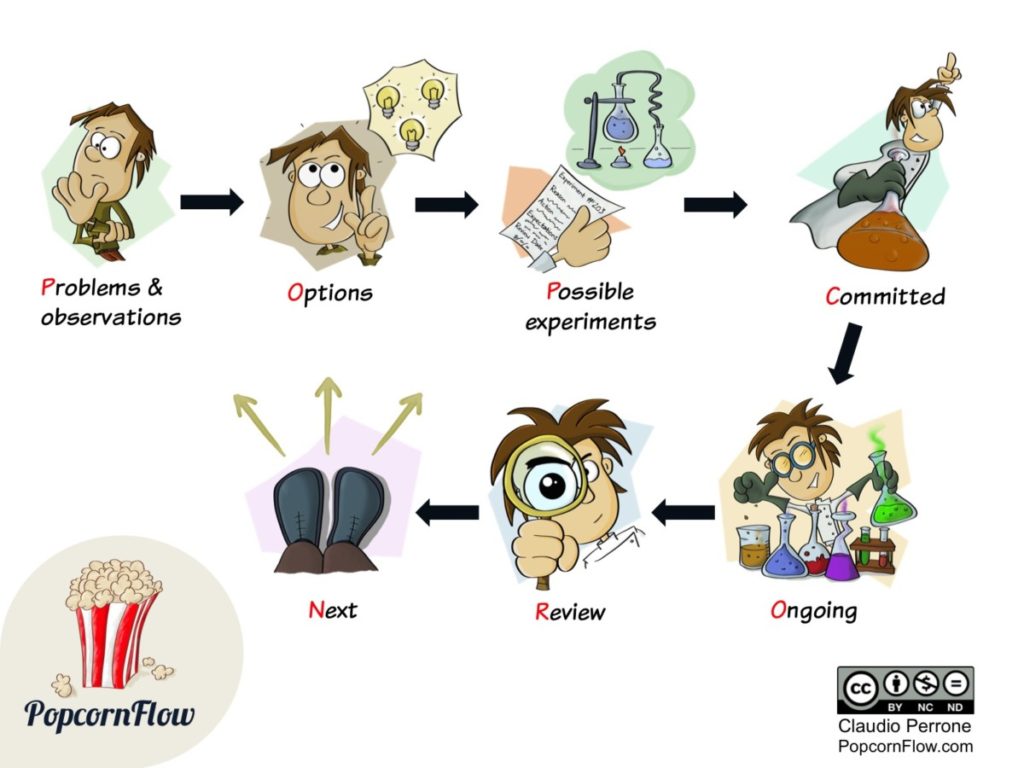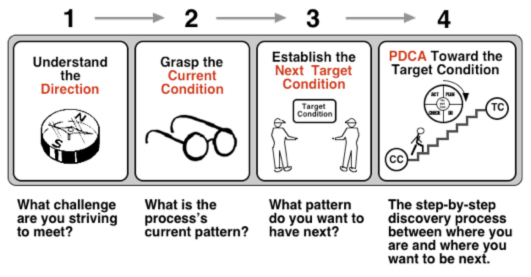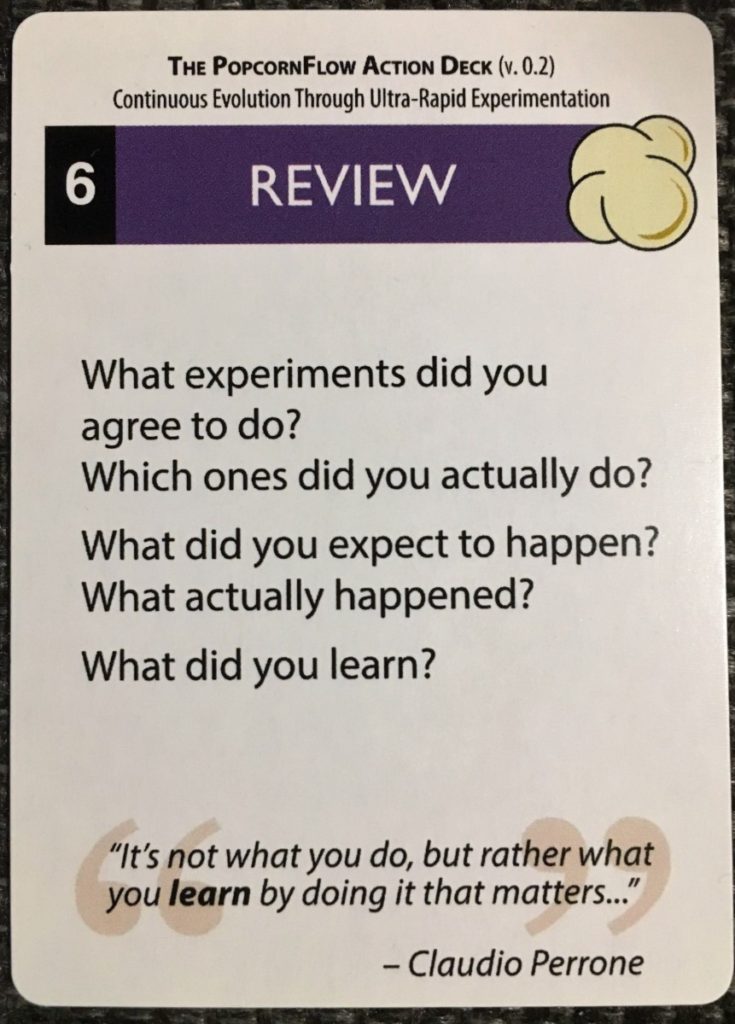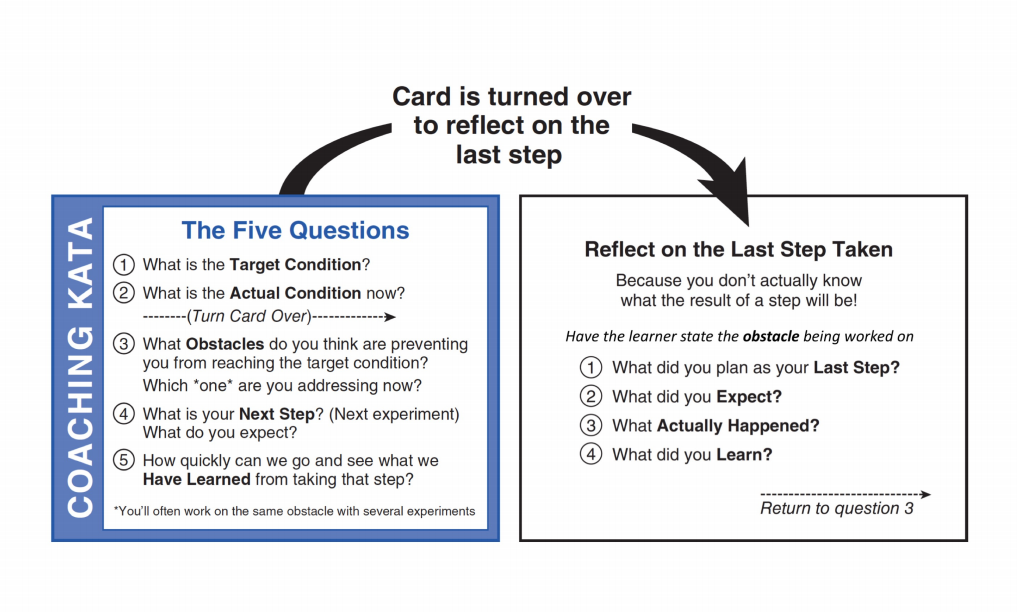GOTO København 2018 er slut. Jeg var så heldig at få lov til at deltage i hele to lærerige kurser: Popcornflow med Claudio Perrone @agilesensei og Toyota Kata med Jesper Boeg @j_boeg. Begge kursusholdere skriver på bøger om emnet og begge kurser har fokus på noget der ligger mit hjerte nær: Forbedring, læring og eksperimenter.
Popcornflow er en inspirerende måde at skabe valideret læring gennem løbende eksperimentering.
Toyota Kata er en struktureret og fokuseret tilgang til at skabe en løbende lærings- og forbedrings-kultur. En kaizen kultur.
Forskellig tilgang til eksperimenter
Det er to forskellige tilgange til eksperimenter.
Popcornflow proces
Popcornflow fokuserer på at gøre forandring til noget vi altid gør – og dermed bliver det nemmere med tiden. “If change is hard, make it continuous”.
Toyota Kata forbedrings-proces
Toyota Kata fokuserer på bryde forandringer ned i små steps, så vi kan nå et stort mål og arbejde struktureret med forandringer (sæt et mål, forstå hvor vi er, sæt delmål, udfør eksperiment, evaluer, behandl forhindringer, tag næste skridt mod et nyt delmål indtil vi når vores store mål).
Popcornflow anbefaler, at man gør mange små ting, som måske/måske ikke peger i samme retning, hvor altså Toyota Kata er designet til at gå målrettet efter et større mål i en “Plan, Do, Check, Act (Adapt)”-cyklus.
Videnskab og professionelle kasser versus kunst og håndtegnet venlighed
De to workshops virkede meget forskellige på trods af de beslægtede emner. Stilen var især en stor forskel – Popcornflow er illustreret af mange tegneserie-agtige illustrationer som Claudio selv har tegnet, mens Toyota Kata er mere forretnings-agtige diagrammer og kasser. Det burde ikke påvirke noget, men jeg fik langt mere lyst til at kaste mig over Popcornflow. Andre vil sikkert have det omvendt.
Claudio Perrone (manden bag Popcornflow) gjorde meget ud af understrege at dette ikke er videnskab, men en kunst, i modsætning til Toyota Kata-metoden som fremhæver en videnskabelig tilgang.
Den eksperimentelle tankegang ligger dog tæt op af hinanden, og Toyota Kata kurset bestod af langt bedre eksempler på gode eksperimenter og mål man kan sætte sig i et software-udviklings-team.
Evaluering af eksperimenter
Derudover tilfører Toyota Kata også en interessant ekstra dimension med en coaching kata, hvor man evaluerer sine eksperimenter med en udenfor teamet (en manager). Få nogle øjne på som ikke er en del af hverdagen. Det handler især om at få sat ord på de ting vi tager for givet indenfor teamet, samt at stille gode opklarende spørgsmål ud fra et objektivt perspektiv. Bare at skulle forberede en gennemgang med en udefra kan give værdi, fordi det sætter ens tankegang på prøve og holder en op på det commitment, man har givet ved at starte et eksperiment. Det mindsker risikoen for at forandringstiltag drukner i hverdag.
Til sammenligning så lægger Popcornflow op til at man selv evaluerer sine eksperimenter – gerne i fællesskab med andre, men det er mindre formaliseret i den proces.
Review-spørgsmål i Popcornflow
Review spørgsmål i Toyota Kata (Coaching Kata)
Det er tydeligt at de to metoder har de basale spørgsmål omkring “Hvad er eksperimentet?”, “Hvad forventede vi at få ud af eksperimentet?”, “Hvad skete der rent faktisk?” og “Hvad lærte vi?”. Derudover har Popcornflow en anerkendelse af at vi ikke altid gør det vi siger vi vil (måske fandt vi hurtigt ud af at det ikke var muligt), og Toyota Kata har fokus på at vi ved hvor langt vi er nået og hvor langt vi har tilbage – og næste eksperiment som skal hjælpe os videre, når vi har behandlet det som holder os tilbage. Toyota Kata har altså lidt mere struktur, men basalt set er evalueringen af eksperimentet næsten det samme.
Konklusion: Både Popcornflow og Toyota Kata er tilgange til at gennemføre flere eksperimenter, men med lidt forskelligt fokus. For mig bliver det nok Popcornflow, som jeg griber fat i først, men det udelukker bestemt ikke at Toyota Kata kan komme på banen hen ad vejen, når jeg får brug for at angribe lidt større problemer med flere skridt på vejen derhen. Faktisk vil jeg tidligt indføre evaluering af eksperimenter med en udenfor teamet, som Toyota Kata anbefaler.
Hvad med jer: Eksperimenterer I? Er I gode til det? Bruger I en af disse to tilgange?




Thanks so much for coming to the workshop and for sharing your thoughts, Therese.
It was a real pleasure to meet you and I’m glad you’ll turn the insights you gained in both workshops into action.
As you know, these approaches have theoretical/practical differences (e.g. complexity theories/biology vs. systems thinking/scientific) but, undeniably, they can both be “hired” for similar jobs-to-be-done in many areas.
Workshop teaching methods aside, I have a genuinely curious intent to further exploring the differences in both approaches, however subtle they might seem at first glance. Not only to understand “how” something worked in a given context, but also “why” (we think) it worked.
In the end, it’s great to have options, as there is no silver bullet that works in every situation.
When all is said and done, either we (and/or our teams/organizations) do experiments or we don’t 🙂
“Talk does not cook rice,” states my favourite Chinese proverb.
Incidentally, I collected hundreds of software-related real-world experiments in different industries and – even more importantly – I (and others) deliberately use PopcornFlow to coach external teams too, so thanks so much for pointing out to potentially missing scenarios/examples/ideas/activities I could include/develop for my training/book.
Let me know how your popcornflow/kata experiments go!!!
Hi Claudio. Wow, I did not expect you to actually read my blog post in Danish! Thank you for making that extra effort. You rock!
I am sure both Popcornflow and Toyota Kata can pick up useful aspects from each other and since I have not used these methods in “the real world”, I’m curious to hear from people with experiences. It was very interesting to attend both workshops.
I would love to hear about more software-related real-world experiments but I do see that there was not time in the one day workshop. There should be an extension :). Jesper, who did the Toyota Kata workshop, mentioned that he had just redesigned his workshop to go from more everyday life examples (loose some weight) to use an example from the participants. It takes up a lot more time, but was also very informative. All in all I would conclude that it was nice to have both perspectives – I loved your examples as well – but to cover both perspectives it would probably be a 2 day workshop each :).
Thank you for a great workshop. I’ll let you know what I learned from all the experimenting we’re going to do :).
Hi Claudio and Therese
Great seeing you both at GOTO 🙂 Nice to get the perspective on both approaches and how you interpret the differences between the two approaches.
It seems there is a big overlap between the two in terms of trying to make improvement and experimentation a part of the daily culture and the continuous follow-up on the result of experiments. Teaching your brain that it is OK to try things out and fail in short cycles is very important.
As Claudio points out the big difference is if you are doing it with a direction in mind. That is really a core aspect of Toyota Kata as the notion is that directed improvement is much more effective than problem solving on your current process. I think there is more to it that just the difference between systems/thinking and complexity theory since Kata also deals quite well with an unpredictable world. It really comes down to whether you believe that you believe there is more to Agile than just the ability to experiment. I would claim that such capabilities as end-user/market feedback, delegation of authority, automation, self-organization, outside-in/customer focus and end-to-end teams are valid parts of a direction to aim for.
Naturally I am devastated that you aim to try out Popcornflow before Toyota Kata Therese, but I’ll also be the first to admit that the entry barrier is probably also lower 🙂
Would love to continue the discussion
Hi Jesper!
Thank you so much for your great workshop and for joining the conversation here as well.
As for your last point – I’m sorry that it wasn’t Toyota Kata that made my heart jump the highest. As I mentioned in the blog post it is mostly a matter of style and need – as I’m not currently doing much structured experiment work (more, “lets try this out, guys and evaluate our gut feeling in a bit of time”), then Popcornflow is already an improvement. It certainly doesn’t mean, I’m never going to try Toyota Kata – just that I’m starting out with another step. Experimenting with experiments! :). The entry barrier does seem to be lower with Popcornflow as you mention. I’m very practical in this respect – I want to maximize my chance for success by making it easier for me to do.
I hope you and Claudio will look into this more. Systems thinking or complexity theory – maybe it is a joint session at GOTO CPH next year? 🙂
Ah ah, I feel I could chat forever on both workshop approaches and methodologies 🙂 Happy New Year to both of you!